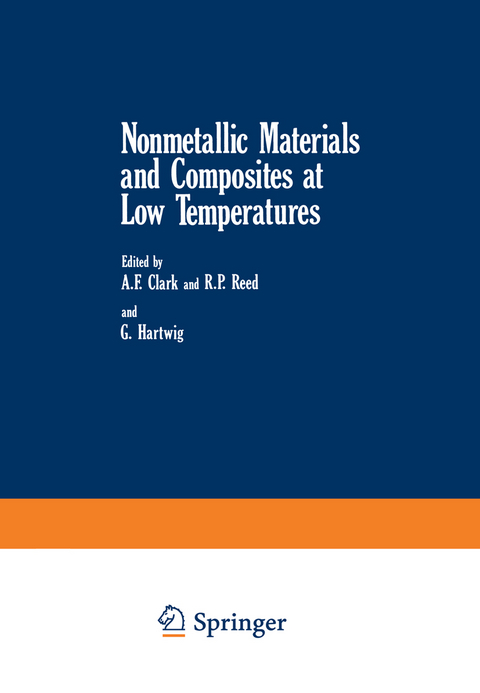
Nonmetallic Materials and Composites at Low Temperatures
Kluwer Academic/Plenum Publishers (Verlag)
978-0-306-40077-3 (ISBN)
- Titel z.Zt. nicht lieferbar
- Versandkostenfrei innerhalb Deutschlands
- Auch auf Rechnung
- Verfügbarkeit in der Filiale vor Ort prüfen
- Artikel merken
Polymers.- Polymers in Low Temperature Technology (Invited).- Mechanical and Electrical Low Temperature Properties of High Polymers (Invited).- Spectroscopic Analysis of High Polymers for Use at Low Temperatures (Invited).- Correlation between Valence Energies and Low Temperature Flexibility.- Polymers — Electrical Properties.- The Dielectric Loss of Polypropylene Films and Polypropylene-Polyurethane Laminates at Cryogenic Temperatures.- Variation of Dielectric Microwave Losses in Polyethylene as the Result of Different Sample Treatments.- Dielectric Loss Spectra of Polyethylenes.- Flashover Behavior of Spacers at Low Temperatures.- Polymers — Physical Properties and Radiation Effects.- Fracture Properties of Epoxy Resins at Low Temperatures.- Interesting Low Temperature Thermal and Mechanical Properties of a Particular Powder-Filled Polyimide.- Radiation Effects on Insulators for Superconducting Magnets.- Effect of Low Temperature Reactor Irradiation on Organic Insulators in Superconducting Magnets.- Thermal Insulations.- Cryogenic Foam Insulations: Polyurethane and Polystyrene (Invited).- Durability of Foam Insulation for LH2 Fuel Tanks of Future Subsonic Transports.- Strength Specifications and Methods of Test for Structural Grades of Cryogenic Balsa Wood Insulation.- Composites — Properties of Fibers and Composites.- Carbon-Fibre-Reinforced Carbon Composites: Processing, Room Temperature Properties, and Expansion Behaviour at Low Temperatures (Invited).- Dynamic Elastic Modulus and Internal Friction in Fibrous Composites.- Compressive Fatigue Tests on a Unidirectional Glass/Polyester Composite at Cryogenic Temperatures.- Powder-Filled Epoxy Resin Composites of Adjustable Thermal Contraction.- Effect of Strain on Epoxy-Impregnated Superconducting Composites.-Thermophysical Properties of Composite Materials Based on High-Molecular Compounds with Fibrous Filler between 10 and 400 K.- Composite and Polymer Applications.- Cryogenic Applications of Composite Technology in the U.S.A. (Invited).- Properties of Plastic Tapes for Cryogenic Power Cable Insulation (Invited).- The Manufacture and Properties of a Glass Fabric/Epoxy Composite Bellows.- Laminated Fiberglass Composites for Cryogenic Structures in Underground Superconductive Energy Storage Magnets.- Selection of Materials and Manufacture of a Superconducting 0.60 MJ Pulsed Energy Storage Coil.- Application of Graphite-Epoxy to Cryogenic Telescopes.- Vacuum Impregnation with Epoxy of Large Superconducting Magnet Structures.- An Outline Design for a Cryogenic Internally Insulated Liquefied Natural Gas Pipeline for Arctic Gas Recovery.- Indexes.- Contributor Index.- Material Index.
| Reihe/Serie | Cryogenic Materials Series |
|---|---|
| Zusatzinfo | 52 Illustrations, black and white; XVI, 440 p. 52 illus. |
| Sprache | englisch |
| Themenwelt | Naturwissenschaften ► Chemie ► Anorganische Chemie |
| Technik ► Maschinenbau | |
| ISBN-10 | 0-306-40077-4 / 0306400774 |
| ISBN-13 | 978-0-306-40077-3 / 9780306400773 |
| Zustand | Neuware |
| Informationen gemäß Produktsicherheitsverordnung (GPSR) | |
| Haben Sie eine Frage zum Produkt? |
aus dem Bereich


